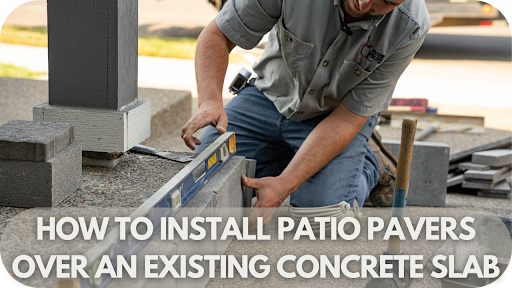
An old, cracked concrete slab can make any outdoor space feel tired and uninspired. Instead of tearing it out, imagine transforming it into a beautiful, functional patio with minimal effort.
By installing pavers over the existing concrete, you can give your backyard a fresh new look without the mess or expense of starting from scratch.
Curious how it works? Keep reading – you’re just a few steps away from creating the patio of your dreams!
Tools and Materials You’ll Need
Having the right tools and materials before starting the installation is crucial for a smooth and successful project.
- Tape Measure: This is used to ensure accurate measurements for paver placement.
- Spirit Level: This is to check that the surface is perfectly even and level.
- Broom: This is used to sweep away debris and spread sand into joints.
- Rubber Mallet: This is used to adjust pavers into position without causing damage.
- Plate Compactor: This is for compacting pavers and sand to create a stable base.
- Masonry Saw or Angle Grinder: This is used for cutting pavers to fit corners and edges precisely.
- High-Quality Pavers: These are used to create a durable and visually appealing patio surface.
- Coarse Sand or Polymeric Sand: To build a stable base and secure paver joints.
- Edge Restraints: These are used to prevent pavers from shifting or spreading over time.
- Self-Levelling Compound: For smoothing out dips or uneven areas on the slab.
- Adhesive or Bonding Agent: For securing pavers in high-traffic or sloped areas.
Step-by-Step Installation Process
Transforming your dull concrete slab into a stunning patio is easier than you think. Follow these simple steps to achieve a professional, durable finish that enhances your outdoor space.
Step 1: Assess the Existing Concrete Slab
Start by checking the slab’s structural integrity. Look for cracks, uneven surfaces, or instability, and repair any minor issues to ensure a solid base. Confirm the slab has a slight slope for proper water runoff. If drainage is poor, consider using drainage solutions like installing weep holes.
Step 2: Prepare the Concrete Surface
Using a power washer, clean the slab thoroughly to remove dirt, grease, and debris. If there are any dips or uneven spots, apply a self-levelling compound to smooth out imperfections. For added paver stability, spread a thin layer of mortar or adhesive as a bonding layer.
Step 3: Lay the Paver Base
Spread a thin, even layer of coarse sand or bonding adhesive over the cleaned concrete surface. This layer creates a stable and level foundation for the pavers. Ensure the sand or adhesive is evenly distributed to avoid future shifting or unevenness when placing the pavers.
Step 4: Place the Pavers
Start placing the pavers in your chosen pattern, such as herringbone or basket weave. Use a level to maintain even alignment and a rubber mallet to adjust each paver gently into place. Pay attention to spacing for a uniform and professional finish.
Step 5: Install Edge Restraints
Edge restraints are essential for keeping the pavers in position over time. Place them around the perimeter of the patio to prevent shifting or spreading. Secure the restraints using adhesive or ground anchors to ensure they remain firm, especially in high-traffic areas.
Step 6: Fill the Joints
Seal the paver joint for longevity. Spread polymeric sand evenly across the paver surface, sweeping it into the joints with a broom. Remove any excess sand from the surface, then lightly mist it with water to activate the binding agent. Allow the sand to settle and harden for a strong, long-lasting bond.
Step 7: Compact the Surface
Use a plate compactor to press the pavers firmly into place, ensuring they settle evenly into the base. This step enhances stability and reduces gaps. After compacting, check for alignment and fill any remaining gaps with additional sand for a smooth, polished finish.
Step 8: Seal the Pavers
Apply a high-quality paver sealant. Sealing protects the surface from stains, weather damage, and wear. Use a roller or sprayer for even coverage, and allow the sealant to dry completely. Paver sealing ensures longevity, enhances the pavers’ colour, and keeps your patio pristine for years.
Benefits of Installing Patio Pavers Over Concrete
Transforming your existing concrete slab with patio pavers is a smart, cost-effective way to enhance your outdoor space. Below are the key benefits of installing patio pavers over concrete, each offering practical and aesthetic advantages for your home.
1. Ease of Installation
Installing pavers over concrete eliminates the need for slab removal, saving time, money, and labour. The process is straightforward and far less disruptive, allowing you to achieve a brand-new patio with minimal hassle while avoiding the mess of a full demolition.
2. Design Versatility
Pavers come in a wide range of materials, patterns, and colours, making it easy to match your style preferences. Whether you love the timeless appeal of natural stone or the clean finish of interlocking concrete pavers, the design options are virtually endless.
3. Durability and Longevity
High-quality pavers are designed to withstand heavy foot traffic, changing weather conditions, and wear over time. Their robust nature ensures a long-lasting, sturdy patio surface that remains beautiful and functional for years with proper care.
4. Low Maintenance
Maintaining pavers is simple and cost-effective. Regular sweeping, occasional washing, and reapplying joint sand or sealant keep the surface looking fresh and clean, without the cracks or major repairs often associated with concrete slabs.
5. Increased Property Value
A well-designed patio adds significant value to your home. Pavers not only improve curb appeal but also enhance the overall functionality of your outdoor space, making your property more attractive to potential buyers.
6. Improved Aesthetics
Pavers instantly upgrade the look of an old, worn concrete slab. Their elegant finish creates a warm, inviting outdoor area perfect for relaxing, entertaining, or showcasing a professionally designed landscape.
Common Problems and Fixes For Installing Pavers Over Concrete
While installing pavers over concrete is straightforward, a few challenges can arise if not addressed correctly. Understanding these common issues—and their fixes—will ensure your patio remains durable and visually appealing for years to come.
Poor Drainage
If water pools on the concrete, it weakens the paver base over time and causes instability. To fix this, ensure the concrete has a proper slope for runoff. For stubborn water retention, drill small weep holes into the slab to allow water to escape effectively.
Paver Movement
Pavers can shift or spread if edge restraints are overlooked during installation. Installing sturdy edge restraints and securing them with strong adhesive or ground anchors prevents unwanted movement. This step is crucial for maintaining stability in high-traffic areas.
Uneven Surface
Dips and bumps in the concrete can make the pavers unstable and uneven. Apply a self-levelling compound to fill low spots and smooth imperfections. Once levelled, add a thin layer of sand or adhesive to create a strong, even foundation for the pavers.
Joint Sand Loss
Regular sand between paver joints can wash out over time, leading to loose pavers and weed growth. Replace it with polymeric sand, which hardens when wet, locking pavers into place. This creates a solid bond while resisting erosion, weeds, and heavy rains.
Maintenance Tips for Patio Pavers
With proper care, a beautifully laid patio can stay stunning for years. The good news is that maintaining patio pavers is simple and doesn’t require expensive tools or excessive effort. Follow these tips to keep your outdoor space looking polished and functional season after season.
- Regular Cleaning: Sweep weekly to remove dirt, leaves, and debris. Use water and mild detergent to lift stains for a deeper clean, ensuring you rinse thoroughly.
- Reapply Joint Sand: Over time, sand between the pavers can erode. Use polymeric sand to refill joints—it hardens when wet and resists weeds, insects, and washout.
- Seal the Surface: Apply a quality paver sealant every 2–3 years to protect against stains, fading, and weather damage while enhancing the paver colour.
- Address Weeds and Moss: Remove weeds or moss promptly and treat the joints with an appropriate weed or moss killer to prevent regrowth.
- Check for Movement: Inspect the pavers for shifting or uneven areas. Reset the affected pavers and reapply joint sand to maintain a stable surface.
- Prevent Staining: Avoid spills from oil, food, or chemicals. Clean stubborn stains immediately to prevent long-term discolouration or surface damage.
- Protect Against Harsh Weather: Avoid using metal shovels or de-icing salts in colder climates, as they can scratch or degrade the paver surface. Instead, use plastic tools and gentle ice-melting alternatives.
Conclusion
Transforming your old concrete slab with patio pavers is a cost-effective and rewarding way to elevate your outdoor space. With the right tools, materials, and steps, you can create a stunning, durable patio that enhances both functionality and style.
Ready to bring your vision to life? At Splendour in Stone, we offer premium pavers and expert advice to help you achieve the perfect finish. Explore our range today and start your patio transformation with confidence!
More To Explore

Stone Accents: Adding Charm to Modern Interiors with Natural Stone
Modern interiors seek a balance of style, durability, and uniqueness. Natural stone accents are a game-changer, adding timeless elegance and character to any space. As

Natural Stone Features That Will Transform Your Living Room
Natural stone elevates any living room with elegance, texture, and timeless appeal. Its versatility allows it to enhance both modern and traditional spaces. From stone


